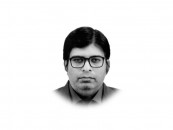Listen to the future
The future is talking to us. We better listen.

The writer is a Howard Hughes Medical Institute professor of biomedical engineering, international health and medicine at Boston University.
He tweets @mhzaman
Compiled under the leadership of Dr Adil Najam and Dr Faisal Bari, with efforts from hundreds of other collaborators the report is a reflection of the hopes and aspirations, fears and worries, of those who will be writing our next, and perhaps most pivotal part, of our national history. Compiled meticulously through workshops, seminars, focus groups, interviews and formal and informal surveys, the picture that emerges is that of an engaged youth that thinks and cares about the country.
Notably, the report dispels a number of myths. It is not a tale of an ambivalent demographic, but instead of those who recognise that not all is well. It is not a reflection of those who care only about material gains of development, but a tapestry of views and opinions about where we are headed as a society. And as the worry about employment is there, there’s also the erosion of core values of honesty and fair play. The tapestry connects girls in Sheikhupura to those in Quetta, as both want safer and more dignified job opportunities for women. The tapestry stitches together the views of urban youth in Islamabad with their peers in Kalash, both hoping for an ecosystem that fosters innovation. The fears of youth in Larkana and those of domestic workers in Peshawar connect them on a single point: increased opportunities and better access for high-quality education. This tapestry is rich, it is vibrant, and it is what Pakistan and its future is all about.

The report is also rich in data. Data that should make us pause, reflect, and worry. Nearly a third of the youth has no education whatsoever, and only one in sixteen youth has finished 12th grade. Only one in 20 has ever accessed a library and 93% has no access to a sports facility. But there is also data that should make us see the glass half-full. 80% are actively engaged in the democratic process (through voting) and 2/3rd feel that they are better off than their parents and despite all that we have gone through nearly 70% feel safe in the country. Most importantly, it should make us question on what the future is telling us. It should make us ponder on what it means for youth to be fearful or optimistic, upbeat or dejected. It should make us question why is a third of our youth without education and what does their future look like? It should also ask, how to translate that sense of general happiness (nearly 90% said that they are happy in the country) into inclusion and fairness for all, from the transgender people in Faisalabad to the Hazara in Balochistan.
The report reminded me of Iqbal who had said nearly a century ago — “Rang Gardoon ka zara dekh to unnabi hai, yeh ubhartay hue suraj ki ufaq taabi hai” (And look at the russet hue on the horizon, for indeed it is the dawn of a new sunrise).
The future is talking to us. We better listen.
Published in The Express Tribune, May 1st, 2018.
Like Opinion & Editorial on Facebook, follow @ETOpEd on Twitter to receive all updates on all our daily pieces.














COMMENTS
Comments are moderated and generally will be posted if they are on-topic and not abusive.
For more information, please see our Comments FAQ